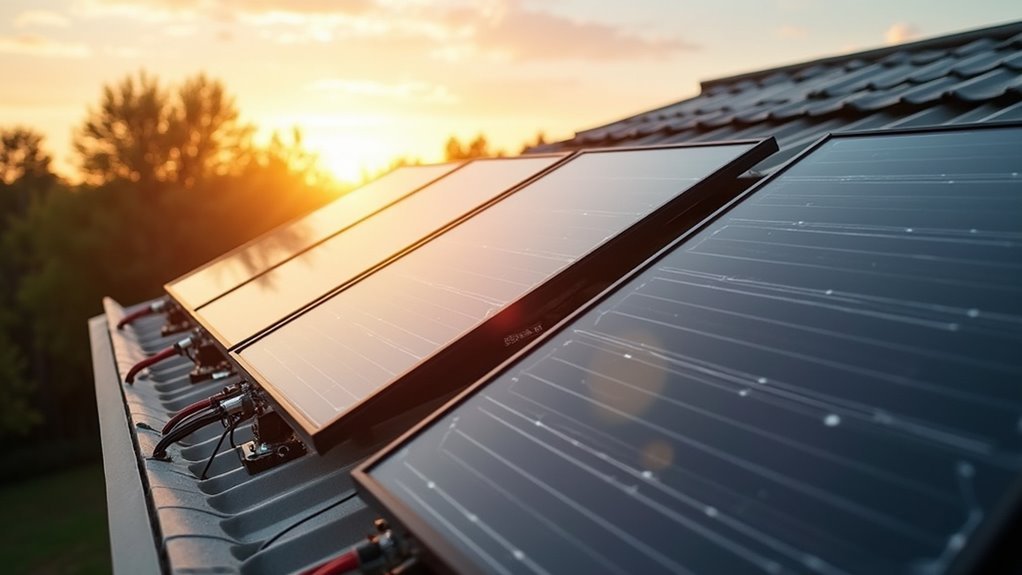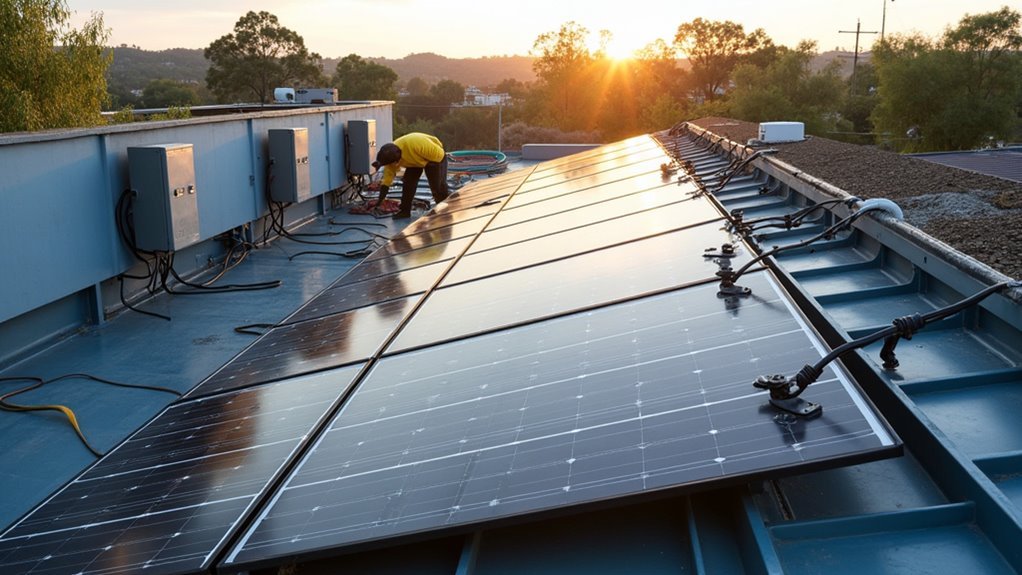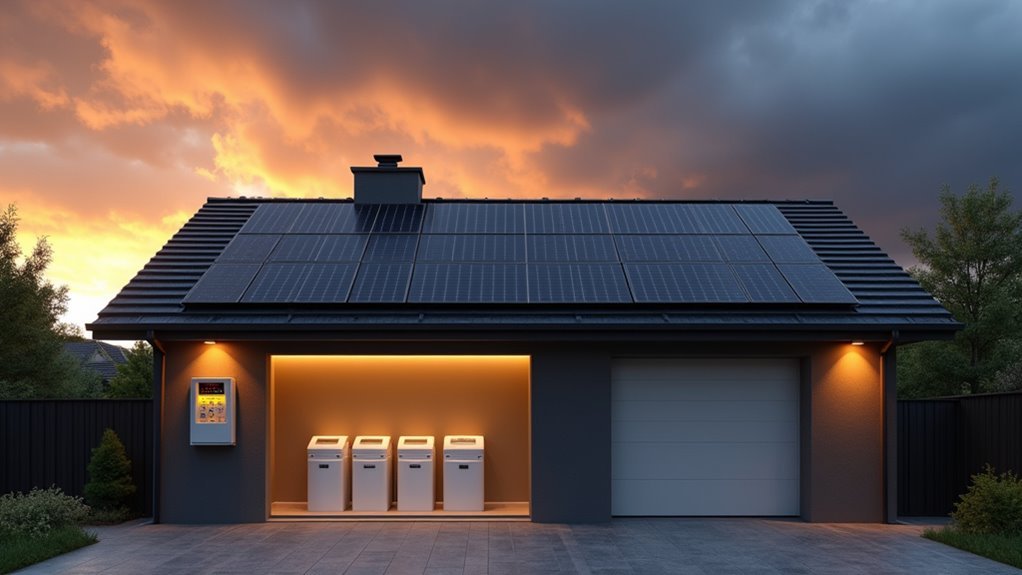Solar roofing sheets aren’t sufficient on their own for a functional home solar system. You’ll need several critical components including inverters to convert DC to AC power, battery storage for excess energy, and monitoring systems to track performance. A complete installation typically costs $15,000-$35,000 and requires proper mounting hardware, structural assessment, and professional installation. Understanding the full system requirements will help you make an informed decision about your solar investment.
Understanding Solar Roofing Sheet Technology

While traditional solar panels are mounted on existing roofs, solar roofing sheets integrate photovoltaic technology directly into roofing materials. These novel sheets feature thin-film solar cells embedded within durable, weather-resistant materials that serve both as your roof and power generator.
You’ll find that solar panel efficiency in roofing sheets typically ranges from 14-18%, compared to 20-23% in conventional panels. However, what you lose in efficiency, you gain in coverage area and aesthetics. The solar panel durability of these sheets matches standard roofing materials, with warranties extending 20-25 years for power generation and 30 years for weather protection.
The technology uses either monocrystalline or thin-film cells, with each type offering distinct advantages with respect to cost, weight, and performance under different climate conditions.
Evaluating Your Home’s Solar Potential
Before installing solar roofing sheets, determining your home’s solar energy potential helps optimize your investment returns. Start by conducting residential energy audits to assess your current power consumption patterns and identify efficiency improvements that could reduce your overall energy needs.
Evaluate your roof’s structural integrity, angle, and available surface area. Solar panel orientation plays a pivotal role – south-facing installations in the Northern Hemisphere typically generate maximum power. You’ll need to mull over shade from nearby trees, buildings, or other obstructions that could impact energy production throughout the day.
Use solar calculation tools to estimate your roof’s peak sun hours and potential energy yield. Factor in local weather patterns, seasonal variations, and your region’s solar irradiance levels to project accurate energy generation capabilities and financial returns.
Essential Components Beyond Solar Sheets

Although solar roofing sheets form the core of your solar system, several critical components work together to create a functional solar power setup. You’ll need to guarantee proper integration of these elements to optimize your system’s efficiency and power generation capacity.
- Inverters: Convert DC power from your solar sheets into usable AC power, with modern micro-inverters achieving up to 97% conversion efficiency.
- Battery Storage System: Stores excess energy for nighttime use or backup power, typically offering 5-15 kWh capacity for residential setups.
- Mounting Hardware: Ensures ideal solar panel orientation and panel angle optimization, typically between 30-45 degrees based on your latitude.
- Monitoring System: Tracks real-time performance, energy production, and system health through wireless connectivity, helping you identify issues and enhance output.
Climate and Weather Impact Assessment
You’ll need to evaluate your region’s weather patterns, including annual rainfall, wind speeds, and temperature fluctuations, to determine the ideal solar roofing sheet specifications for your installation. Third-party storm resilience testing demonstrates that quality solar sheets can withstand winds up to 140 mph and hail impacts of 1-inch diameter at 50 mph. Your system’s seasonal performance will vary based on factors like sun angle and cloud cover, with efficiency typically dropping 10-20% during winter months compared to peak summer output.
Regional Weather Patterns
Understanding regional weather patterns plays an essential role in maximizing solar roofing sheet performance and longevity. You’ll need to analyze your area’s specific climate characteristics to guarantee optimal energy generation and system durability.
- Monitor seasonal temperature fluctuations in your region, as extreme heat can reduce solar panel efficiency by 0.5% for every degree above 77°F (25°C)
- Track precipitation patterns to determine if you’ll need supplementary protective coatings or reinforced mounting systems to handle heavy rainfall or snow loads
- Assess your location’s average cloud cover throughout the year, which can impact solar energy production by 10-25% on overcast days
- Consider wind patterns and speed variations, as areas with frequent high winds may require heightened mounting hardware and structural support to prevent damage
Storm Resilience Testing
Several critical tests evaluate solar roofing sheets’ resilience against severe weather conditions and potential storm damage. You’ll need to guarantee that your chosen panels meet standardized testing requirements for debris impact resistance and hail damage protection.
The most rigorous assessments simulate wind-driven debris at speeds up to 110 mph and hailstones measuring 1-2 inches in diameter. Your solar sheets should withstand these impacts without compromising their structural integrity or power generation capabilities. Testing labs also examine water infiltration resistance under extreme precipitation and wind uplift forces exceeding 140 mph.
When reviewing test results, you’ll want to focus on UL 2703 certification data and FM approval ratings, which indicate proven performance in real-world storm scenarios. These certifications ensure your investment remains protected during severe weather events.
Seasonal Performance Variations
Beyond storm resilience, seasonal weather patterns considerably impact solar roofing sheet performance throughout the year. You’ll notice significant seasonal performance variations as temperature fluctuations affect your system’s efficiency. Understanding these patterns helps you optimize your energy production and manage expectations.
- Summer yields peak performance with 15-20% more energy generation, though extreme heat above 95°F (35°C) can reduce efficiency by 10-25%
- Winter months typically show 30-40% lower output due to shorter days and snow coverage
- Spring and fall offer moderate but consistent performance, averaging 60-75% of peak summer capacity
- Temperature fluctuations between day and night can impact voltage output by 2-3% for every 10°F change, requiring voltage regulators for stability
Cost-Benefit Analysis of Complete Systems
While initial costs for solar roofing sheet systems range from $15,000 to $35,000 for residential installations, the long-term financial benefits typically offset this investment within 5-8 years. You’ll need to factor in supplementary components beyond just the sheets, including inverters ($1,000-$2,500), mounting hardware ($500-$1,000), and professional installation ($3,000-$5,000).
Your payback period depends on several variables: local electricity rates, available tax incentives, and your home’s energy consumption patterns. The environmental impact translates to financial gains through carbon credit programs in some regions. You’ll save $1,200-$1,800 annually on electricity bills, while increasing your property value by 4-6%. When calculating ROI, remember to include maintenance costs ($150-$300/year) and inverter replacement every 10-15 years.
Energy Storage Solutions and Backup Power

You’ll need to choose between lithium-ion, lead-acid, or flow battery systems to effectively store your solar roofing sheet’s energy output, with each offering distinct capacity-to-cost ratios and lifecycle considerations. Your decision between maintaining grid connectivity or pursuing complete energy independence will impact both your storage requirements and backup power capabilities during outages. To optimize emergency power management, you should calculate your critical load requirements and implement a smart monitoring system that automatically prioritizes essential circuits when operating on stored power.
Battery Storage System Types
When integrating solar roofing sheets into your home’s energy system, selecting the right battery storage solution becomes essential for maximizing power efficiency and ensuring reliable backup during outages. You’ll need to understand the main battery types available for residential solar installations.
- Lithium-ion batteries offer high energy density with 85-95% efficiency and 10-15 years of lifespan, providing 5-15kWh of storage capacity for typical homes
- Lead-acid batteries present a budget-friendly option with 70-85% efficiency, though they require more maintenance and have shorter lifespans of 5-10 years
- Saltwater batteries deliver an eco-friendly alternative, using non-toxic materials and offering 5-7kWh capacity with 90% depth of discharge
- Hybrid energy storage systems combine multiple battery types to optimize performance, allowing you to balance cost, efficiency, and environmental impact while maintaining reliable backup power
Grid Connection Vs Independence
Since power independence remains a key consideration for solar roofing installations, understanding the tradeoffs between grid connection and complete autonomy is crucial for system design.
When you maintain grid connectivity, you’ll benefit from net metering programs that credit your excess power generation against consumption. Utility grid integration provides backup power during low solar production periods and eliminates the need for extensive battery storage. However, you’ll still face utility charges and remain vulnerable to grid outages.
Going off-grid gives you total energy independence but requires significant battery capacity and backup systems. You’ll need to size your system 20-30% larger to account for seasonal variations and guarantee reliable power year-round. The initial investment is higher, but you’ll eliminate monthly utility bills and gain immunity from grid disruptions.
Emergency Power Management
Three critical components form the foundation of emergency power management in solar roofing systems: battery storage capacity, intelligent load management, and backup power integration. You’ll need to assess your backup power needs and develop an emergency preparedness planning strategy to guarantee reliable power during outages.
- Calculate your essential power requirements by identifying critical loads (refrigeration, medical equipment, security systems) that must remain operational during emergencies
- Size your battery storage system to maintain these critical loads for your desired duration (typically 24-72 hours)
- Install an automatic transfer switch to effortlessly shift between grid and backup power without interruption
- Monitor and manage your energy consumption through a smart inverter system that prioritizes critical loads and extends battery life during outages
Installation Requirements and Structural Considerations
Before installing solar roofing sheets, your existing roof structure must meet specific load-bearing requirements to support the supplementary weight of 2-4 pounds per square foot. You’ll need a professional assessment to evaluate your roof’s structural integrity and determine if reinforcement is necessary.
Local permitting requirements vary, but you’ll typically need electrical and building permits before installation begins. Your roof’s pitch should ideally be between 15-40 degrees for ideal solar absorption, and the surface must be free of shade from nearby trees or structures. The underlying roofing material should have at least 10 years of life remaining to avoid costly removal and reinstallation of the solar sheets.
Check your roof’s orientation – south-facing surfaces in the Northern Hemisphere receive maximum sun exposure, while north-facing ones may not be suitable.
Maintenance and Long-Term Performance
Regular maintenance of solar roofing sheets greatly impacts their efficiency and longevity, with proper care extending their lifespan to 25-30 years. You’ll need to implement a preventative maintenance schedule to guarantee optimal performance and protect your investment.
- Clean your panels quarterly using soft brushes and specialized cleaning solutions to remove dirt, leaves, and bird droppings that can reduce efficiency by up to 25%
- Conduct bi-annual inspections to check for microcracks, loose connections, and degraded sealants that could lead to water infiltration
- Monitor system performance through your inverter data to identify efficiency drops, enabling quick troubleshooting
- Use longevity forecasting tools to predict maintenance needs and plan for component replacements, typically inverters at 10-15 years and optimizers at 15-20 years
Grid Connection vs. Stand-Alone Systems
Most solar roofing installations require choosing between grid-connected and stand-alone systems, each offering distinct advantages for different use cases. Grid-connected systems let you maintain reliable power access while benefiting from financial incentives and flexible billing plans through net metering. You’ll export excess energy to the grid during peak production and draw power when needed.
Stand-alone systems, however, provide complete energy independence through battery storage. You won’t need to worry about grid outages or utility rate increases, but you’ll need to carefully size your system to meet peak demands. These systems work best for remote locations where grid connection isn’t feasible or cost-effective. The initial investment is typically higher due to required battery banks and charge controllers, but you’ll avoid monthly utility fees entirely.
Comparing Solar Sheets With Alternative Solutions
When evaluating solar roofing solutions, solar sheets present unique advantages compared to traditional panels and other alternatives. Your choice impacts both immediate installation costs and long-term energy production.
- Solar sheets offer 15-20% less weight load on your roof structure compared to traditional panels, though their energy efficiency comparison shows a 10-15% lower power output per square foot
- Traditional panels maintain superior solar panel durability, lasting 25-30 years versus 20-25 years for sheets
- Solar sheets integrate seamlessly with existing roofing, eliminating the need for mounting hardware and reducing installation costs by 30%
- While sheets cost about 5-10% more upfront than conventional panels, their simplified installation and reduced maintenance requirements can offset this premium within 5-7 years through lower operational costs
Frequently Asked Questions
Can Solar Roofing Sheets Be Installed on a Curved or Dome-Shaped Roof?
Yes, you can install solar roofing sheets on curved or dome-shaped roofs, but there are unique installation requirements to ponder. You’ll need specialized mounting systems and flexible solar panels designed specifically for non-traditional surfaces. The compatibility with architectural design is vital, as the panels must follow the roof’s curvature while preserving ideal sun exposure. Furthermore, you’ll require professional installers experienced with curved surface installations to guarantee proper functionality.
Do Solar Roofing Sheets Affect My Home’s Resale Value?
Solar roofing sheets typically increase your home’s resale appeal and can elevate property value assessments by 4-6% on average. You’ll find that prospective buyers often view solar installations as valuable upgrades that offer long-term energy savings. Research shows homes with solar installations sell 20% faster than those without. However, the value increase depends on your local real estate market, installation quality, and the system’s vintage and efficiency.
What Happens to Solar Roofing Sheets During a Power Outage?
During a power outage, your solar roofing sheets will automatically shut down for safety reasons, even if the sun is shining. This is due to grid integration challenges and anti-islanding requirements. To maintain power during outages, you’ll need a battery storage system. Without batteries, your solar sheets can’t operate independently from the grid. Installing a backup battery system lets you store excess energy and power your home during blackouts.
Are Solar Roofing Sheets Noisy During Rain or Hail Storms?
You’ll find that solar roofing sheets are designed with sound dampening features that minimize noise during rain and hail. Most modern panels include multiple layers of weatherproofing performance materials, including tempered glass and polymer backsheets, which effectively reduce impact sounds. Testing shows they’re typically no louder than traditional roofing materials. However, if noise is a concern, you can request supplementary sound-reducing underlayment during installation for improved acoustic comfort.
Can Birds or Small Animals Damage Solar Roofing Sheets?
Yes, birds and small animals can cause damage to your solar roofing sheets. Birds’ nesting behavior underneath panels can lead to wiring issues and reduced efficiency, while their droppings can create hotspots. You’ll need protective measures like critter guards or mesh barriers to prevent accidental damage. Regular inspections can help you spot early signs of animal interference, and professional cleaning services can remove debris and nests that might compromise your system’s performance.





